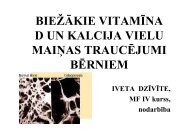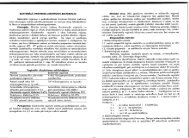PHYSICS
n - susliks.lv
n - susliks.lv
- No tags were found...
You also want an ePaper? Increase the reach of your titles
YUMPU automatically turns print PDFs into web optimized ePapers that Google loves.
adiation arise by photochemical change in the epidermis due to<br />
vasodilation of blood vessels seen as abnormal redness of the skin<br />
or erythema.<br />
Melanogenesis. When exposed to UV radiation, melanocytes in<br />
the germinative layer of the skin produce melanin, which gets<br />
absorbed into the surrounding cells. This creates a protective<br />
barrier from UV radiation.<br />
Antirickets action. Ultraviolet radiation takes part in the<br />
conversion of 7-dehydrocholesterol to previtamin D3 in the skin,<br />
which is thermally isomerized to vitamin D]" The vitamin affects<br />
calcium absorption and the calcification of bones; insufficient<br />
solar UV- B exposure causes rickets in children.<br />
~<br />
Germicidal irradiation. This technology involves the application<br />
,<br />
of ultraviolet radiation for the sterilization of microorganisms<br />
(viruses and bacteria). Death is caused by breakage of bonds and<br />
damage to the organism's DNA.<br />
23.2.2. Terrestrial Plants<br />
A number of physiological and developmental processes in<br />
plants are adversely affected by UV-B radiation. The response to<br />
UV- B radiation varies among species and cultivars of the same<br />
species. As a consequence, it is necessary to use cultivars with<br />
high UV-B tolerance and facilitate the breeding new ones.<br />
Indirect affects induced by UV- B radiation include changes in<br />
plant form, dry matter allocation within the plant, the timing of<br />
developmental phases, and secondary metabolism, each of which<br />
in certain situations can be more important than direct damage<br />
caused by UV-B.<br />
23.2.3. Aquatic Ecosystems<br />
Exposure to solar UV- B radiation results in a significant<br />
reduction in phytoplankton productivity and damage during the<br />
early developmental stages of fish, shrimp, crab, amphibians and<br />
other aquatic animals. The high levels of exposure to solar UV-B<br />
radiation may play a role in phytoplankton distributions; even<br />
small increases in UV-B exposure could result in significant<br />
reduction in the size of the population of consumer organisms.<br />
i<br />
23.3. EFFECT OF PHOTOSYNTHTICALLY ACTIVE<br />
RADIATION ON LIVING ORGANISMS<br />
Light is one of the most important environmental factors<br />
affecting plants. Photosynthetically active radiation (PAR) is radiation<br />
between 400 and 700 nm that is used by plants for<br />
photosynthesis. In this region, leaves have weak reflectance<br />
(15% maximum) and very low transmittance. Most of the radiation<br />
is absorbed by the foliar pigments, primarily chlorophyll a<br />
and b and to a lesser extent by carotenoids. The absorption maxima<br />
of chlorophyll and the carotenoids overlap, such that the presence<br />
of the carotenoids is masked in healthy green leaves.<br />
However, if the chlorophyll concentration diminishes more rapidly<br />
than that of the carotenoids due to stress or senescence,<br />
the leaves become yellow. The primary photobiological reactions<br />
in plants are photosynthesis, phototropism, photoperiodism, and<br />
photomorphogenesis.<br />
23.3.1. Photosynthesis<br />
Photosynthesis is a complex series of light and dark reactions in<br />
which light energy is converted into a stable form of chemical<br />
energy. It involves the absorption of light by a pigment, energy<br />
transfer, energy trapping or stabilization by reaction centres, and<br />
initiation of chemical reactions from donor to acceptor molecules.<br />
Two princi pal photochemical reactions are operating in series,<br />
and the electron acceptor of one of them (reaction 2) is reoxidized<br />
by the other reaction (reaction I), through a chain of electron<br />
carriers. These two photochemical reactions are catalyzed by<br />
two different reaction centres, each one collecting excitation<br />
energy on its antenna consisting of ca. 300 chlorophyll molecules,<br />
organized in several chlorophyll-protein complexes. The functional<br />
unit consisting of a reaction centre and its antenna is defined<br />
aphotosystem (PS). Photosystems I and II are the principal<br />
functional units in the light reactions in plants and algae. The<br />
transfer of the absorbed light energy from the photosystem reaction<br />
centre is accomplished through a series of oxidation-reduction<br />
reactions in which lead to the formation of reduced nicotinamide-adenine<br />
dinucleotide phosphate (NADPH) and adenosine<br />
170 171






